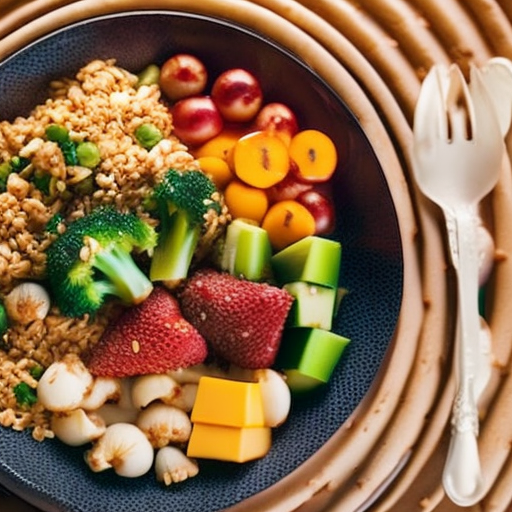Toddler Nutrition: Healthy Eating Habits
Hey there, parent!
Let’s talk about toddler nutrition and how to establish those healthy eating habits.
Picture this: your little one is like a growing tree, and just like a tree needs the right nutrients to thrive, your child needs a balanced diet for optimal growth and development.
It’s no secret that toddlers can be picky eaters, but fear not, we’ve got you covered. In this guide, we’ll explore age-appropriate portion sizes, the importance of balanced meals and snacks, introducing a variety of fruits and veggies, choosing whole grains, incorporating lean protein sources, limiting added sugars and processed foods, encouraging healthy snacking habits, staying hydrated, and strategies for dealing with those picky eaters.
So, let’s dive in and nourish your little one from the roots up!
Key Takeaways
- Age, appetite, and activity level should be considered when determining portion sizes for toddlers.
- Offer nutrient-dense foods like fruits, vegetables, whole grains, lean proteins, and dairy products.
- Introduce a variety of fruits and vegetables to expand your toddler’s palate.
- Incorporate whole grains and lean protein sources into your toddler’s diet for essential nutrients and overall health.
Age-Appropriate Portion Sizes
When serving meals to your toddler, it’s important to consider age-appropriate portion sizes to ensure they’re getting the right amount of nutrients for their growing bodies. Portion control plays a crucial role in maintaining a balanced diet and preventing overeating.
Toddlers have smaller stomachs and lower calorie needs compared to adults, so it’s essential to provide them with appropriate portions that meet their nutritional requirements.
To promote healthy eating habits, focus on offering nutrient-dense foods that are packed with essential vitamins, minerals, and fiber. Nutrient-dense foods provide a higher concentration of nutrients per calorie, making them an excellent choice for growing toddlers. Examples of such foods include fruits, vegetables, whole grains, lean proteins, and dairy products.
When determining portion sizes, consider your toddler’s age, appetite, and activity level. For toddlers aged 1-3 years, a general rule of thumb is to offer about one tablespoon of each food item per year of age. For example, a 1-year-old might be served one tablespoon of vegetables, one tablespoon of fruits, and one tablespoon of grains per meal. As your toddler grows, you can gradually increase portion sizes to meet their changing needs.
Remember, every child is unique, and their appetite may fluctuate from day to day. Encouraging intuitive eating and allowing your toddler to self-regulate their portions can help them develop a healthy relationship with food.
Balanced Meals and Snacks
To ensure your toddler’s healthy eating habits, focus on providing them with well-balanced meals and snacks. Balanced meals and snacks are crucial for your toddler’s growth and development, as they provide essential nutrients and energy.
Here are three tips to help you create balanced meals and snacks for your little one:
-
Practice portion control: Toddlers have small stomachs, so it’s important to offer appropriate portion sizes. Use measuring cups or your child’s hand as a guide. Aim to include a variety of food groups in each meal, such as fruits, vegetables, whole grains, protein, and dairy.
-
Opt for nutrient-dense options: Choose foods that are packed with essential nutrients, such as lean meats, fish, eggs, legumes, fruits, vegetables, whole grains, and dairy products. Avoid processed snacks and sugary drinks, as they provide empty calories and lack important nutrients.
-
Offer a variety of foods: Introduce your toddler to a wide range of foods to ensure they get a variety of nutrients. Encourage them to try new flavors and textures. Include a mix of different fruits, vegetables, proteins, and whole grains in their meals and snacks.
Introducing a Variety of Fruits and Vegetables
Introduce your toddler to a variety of fruits and vegetables to expand their palate and ensure they receive a range of essential nutrients. By introducing different fruits and vegetables, you can help your child develop a taste for a diverse array of flavors and textures. This won’t only make mealtime more exciting, but also contribute to their overall health and well-being.
One way to make fruits and vegetables more appealing to your toddler is by getting creative with recipes. For example, you can make fruit smoothies by blending together a mix of berries, bananas, and yogurt. You can also try making vegetable-based dips, like hummus or guacamole, and serving them with sliced veggies for a fun and nutritious snack.
Incorporating seasonal produce into your toddler’s diet is another great way to introduce variety. Seasonal fruits and vegetables are often at their peak flavor and nutritional value, making them more appealing to young taste buds. Take advantage of what’s available locally and experiment with different options throughout the year.
Choosing Whole Grains
Expand your toddler’s diet and promote their overall health by incorporating whole grains into their meals and snacks. Whole grains offer a variety of benefits that are crucial for your little one’s growth and development.
Here are three ways to incorporate whole grains into your toddler’s meals:
-
Offer whole grain cereals: Start your toddler’s day with a bowl of whole grain cereal, such as oatmeal or whole wheat flakes. These cereals are packed with essential nutrients like fiber, vitamins, and minerals, which help support their digestion and keep them full and energized throughout the day.
-
Use whole grain bread: When making sandwiches or toast for your toddler, opt for whole grain bread instead of white bread. Whole grain bread contains more fiber and nutrients, making it a healthier choice. You can also try whole grain wraps or pitas for added variety.
-
Cook with whole grain pasta and rice: Substitute regular pasta and white rice with whole grain alternatives. Whole grain pasta and rice retain more nutrients and provide a good source of energy for your toddler. They can be used in a variety of dishes, from macaroni and cheese to stir-fried rice.
Incorporating Lean Protein Sources
Incorporate lean protein sources into your toddler’s meals to support their growth and development while promoting overall health.
Protein is an essential nutrient that plays a crucial role in your child’s body. It helps build and repair tissues, supports the immune system, and aids in the production of enzymes and hormones.
While meat and dairy products are common sources of protein, there are also plant-based proteins and alternative protein options that can provide the necessary nutrients for your toddler.
Plant-based proteins such as beans, lentils, quinoa, and tofu are excellent choices for incorporating into your child’s diet. These foods aren’t only rich in protein but also offer other essential nutrients like fiber, vitamins, and minerals. You can add them to soups, stews, salads, or even make bean-based patties or lentil-based pasta sauces as a protein-packed alternative.
Additionally, alternative protein options like Greek yogurt, eggs, and nut butters can also be included in your toddler’s meals. Greek yogurt is a great source of protein and calcium, while eggs provide essential amino acids and vitamins. Nut butters, such as almond or peanut butter, are rich in healthy fats and protein.
Remember to introduce new protein sources gradually and monitor your toddler for any allergies or sensitivities. By incorporating lean protein sources into your toddler’s meals, you can ensure that they receive the necessary nutrients for their growth and development while promoting their overall health.
Limiting Added Sugars and Processed Foods
Cutting back on added sugars and processed foods is essential for maintaining a healthy diet for your toddler. By reducing your toddler’s intake of these unhealthy food options, you can help promote their overall well-being and set them up for a lifetime of good eating habits.
Here are three important steps you can take to limit added sugars and processed foods in your toddler’s diet:
-
Reduce sugary drinks: Sugary drinks, such as soda, fruit juices, and sports drinks, can contribute to excessive calorie intake and increase the risk of tooth decay. Encourage your toddler to drink water, milk, or 100% fruit juice in moderation to keep them hydrated without the added sugars.
-
Read food labels: When shopping for food, it’s crucial to read and understand the labels. Look out for hidden sugars and avoid products that contain high levels of added sugars or artificial ingredients. Choose whole foods, like fruits and vegetables, which are naturally low in added sugars and provide important nutrients.
-
Offer homemade meals: Preparing homemade meals allows you to have control over the ingredients and avoid processed foods. Use fresh, whole ingredients whenever possible and limit the use of packaged snacks or meals. By cooking meals at home, you can ensure that your toddler is getting the nutrients they need without the added sugars and preservatives found in processed foods.
Encouraging Healthy Snacking Habits
To promote healthy snacking habits for your toddler, offer a variety of nutritious options throughout the day. Creative snack ideas can make snacking more fun and enticing for your little one. Instead of reaching for packaged snacks that are often high in sugar and unhealthy additives, try making homemade fruit popsicles using fresh fruits and yogurt, or create a trail mix with a mix of nuts, seeds, and dried fruits. Another idea is to make veggie sticks with a healthy dip like hummus or yogurt-based dressing.
Snacking on the go can be challenging, but with a little planning, you can still provide nutritious options. Prepare small portions of sliced fruits or vegetables and pack them in a portable container. You can also make mini whole-grain muffins or energy balls that are easy to grab and eat on the run. Keep in mind the importance of offering snacks that are easy to hold and eat independently, as this encourages self-feeding and develops fine motor skills.
Remember to offer snacks at regular intervals throughout the day to keep your toddler energized and satisfied. By providing a variety of healthy options and incorporating creative snack ideas, you can help your toddler develop a lifelong habit of making nutritious choices.
The Importance of Adequate Hydration
To ensure your toddler stays healthy and hydrated, it’s important to provide them with an adequate amount of fluids throughout the day. Adequate hydration is crucial for their overall well-being and development.
Here are three key reasons why water intake and maintaining fluid balance are essential for your little one:
-
Prevents dehydration: Toddlers have higher water requirements than adults due to their smaller body size and higher activity levels. Dehydration can lead to fatigue, dizziness, and even more serious health concerns. Providing your toddler with enough fluids helps prevent dehydration and keeps them energized throughout the day.
-
Supports digestion and nutrient absorption: Water plays a vital role in digestion and the absorption of nutrients. It helps break down food, allowing the body to extract essential nutrients. By keeping your toddler well-hydrated, you ensure their digestive system functions optimally, promoting healthy growth and development.
-
Regulates body temperature: Toddlers are more susceptible to changes in body temperature. Drinking enough fluids helps regulate body temperature, ensuring your little one stays cool and comfortable. Proper hydration helps prevent overheating and reduces the risk of heat-related illnesses.
Strategies for Dealing With Picky Eaters
When dealing with picky eaters, it’s important to understand that offering a variety of foods and involving your toddler in meal preparation can help create a positive eating environment.
One strategy for dealing with texture aversions is to gradually introduce new textures. Start by offering foods with a texture your child already enjoys, and then gradually introduce new textures. For example, if your child likes mashed potatoes, you can slowly start adding small pieces of cooked vegetables to the mashed potatoes to increase the texture.
Another strategy is to make mealtime fun and interactive. Encourage your toddler to help with simple tasks, like stirring or pouring ingredients. This can help create a sense of ownership and involvement in the meal, making them more willing to try new foods.
Additionally, try introducing new flavors by offering small tastes of new foods alongside familiar foods. This can help your child become more comfortable with new flavors and increase their acceptance of different foods.
Frequently Asked Questions
How Can I Encourage My Toddler to Eat a Balanced Meal and Snack?
Encourage your toddler to eat a balanced meal and snack by creating a positive mealtime routine. Offer a variety of nutritious foods, involve your child in meal preparation, and be a role model by enjoying healthy meals together.
What Are Some Age-Appropriate Portion Sizes for Toddlers?
To ensure your toddler gets the right portion sizes and encourages balanced meals, it’s important to understand age-appropriate serving sizes. This helps foster healthy eating habits and provides them with the nutrients they need.
How Do I Introduce a Variety of Fruits and Vegetables to My Toddler’s Diet?
To introduce a variety of fruits and vegetables to your toddler’s diet, start by making mealtime fun and creative. Try toddler-friendly meal ideas like fruit kebabs or veggie-filled omelets. Presenting food in a visually appealing way can make it more enticing for your little one.
What Are Some Strategies for Dealing With Picky Eaters?
To help with picky eaters, try these solutions: offer a variety of healthy options, get creative with meal ideas, involve your toddler in meal planning and preparation, and be patient – it may take time for their taste preferences to develop.
How Can I Limit My Toddler’s Intake of Added Sugars and Processed Foods?
You can limit your toddler’s intake of added sugars and processed foods by offering healthy snack options. By choosing fruits, vegetables, and whole grains, you can provide nutritious alternatives that will support their growth and development.
Conclusion
So there you have it, dear reader! By following these age-appropriate portion sizes, providing balanced meals and snacks, introducing a variety of fruits and vegetables, and choosing whole grains, you’ll be setting your little one up for a lifetime of healthy eating habits.
Additionally, incorporating lean protein sources, limiting added sugars and processed foods, and encouraging healthy snacking habits are important steps in promoting their overall health and well-being.
Lastly, don’t forget about the importance of ensuring adequate hydration. Hydrating their bodies is just as crucial as nourishing them with nutritious foods.
Remember, nourishing their bodies is like planting seeds in a garden, cultivating a strong foundation for their future well-being.
Happy eating!







